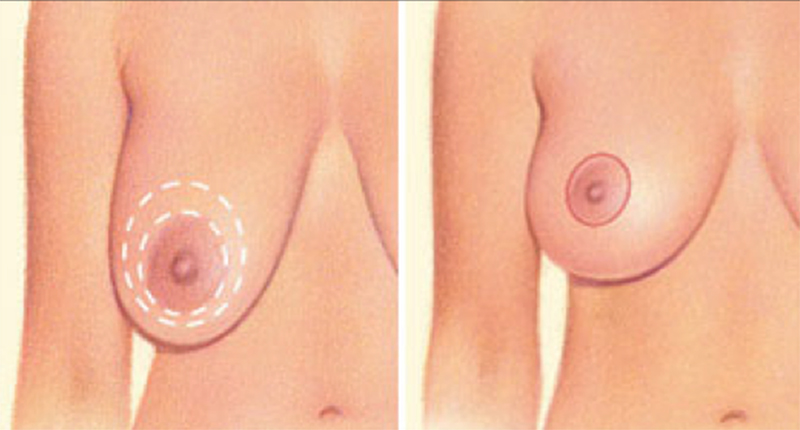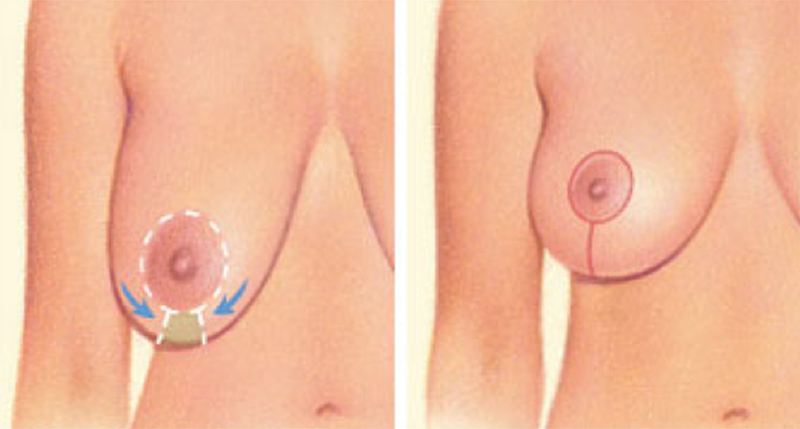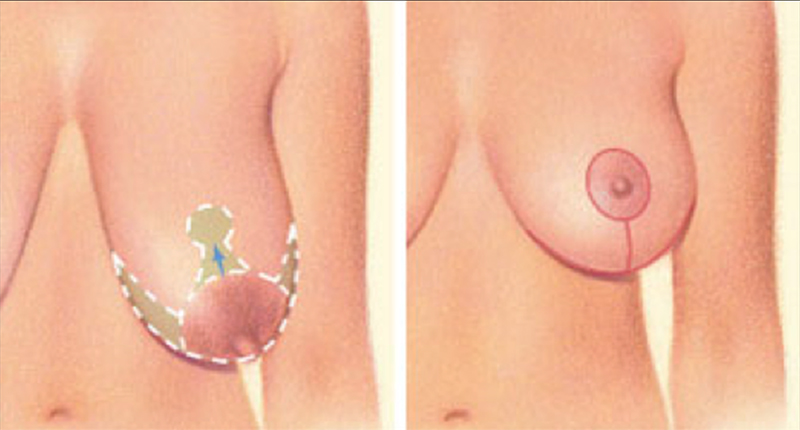- What is a Breast Lift?
- Breast Lift Variations/Options
- Breast Lift Evaluation
- The Breast Lift (Mastopexy) Procedure
- Risks and safety
What is a Breast Lift (Mastopexy)?
A breast lift (or mastopexy) is a procedure to help lift the breast that has lost its shape either due to the pull of gravity, aging or other physical changes such as weight change including gain and loss as that which may occur during pregnancy.
What attributes make an appropriate candidate to undergo a breast lift:
- Good physical health with stable weight
- Nonsmoker
- Bothered by appearance and shape of breasts
- Nipple ptosis (nipples fall below the breast crease)
- Nipples and areola point down
- Stretched and enlarged nipple/areola
- Breasts with different positions/height
Due to the changes in weight and breast size/shape during pregnancy, surgery should be postponed until after completing desired pregnancies. Similarly, significant weight gain or loss can undo the improvement from a breast lift.
A breast lift, also known as mastopexy, elevates the breasts through tightening of breast tissue and removal of redundant skin that has formed over time due to gravity, pregnancy and other factors including weight changes, aging, breatfeeding and heredity. Enlarged areola can also be corrected while performing the breast lift.
Mastopexy can help create a more youthful figure by reversing the changes of time to the female breast and figure.
Since 2000 there has been an increase of breast lift surgery~70% according to new data from the American Society of Plastic Surgeons.
Breast Lift Variations/Options
There are multiple variations to the breast lift procedure – mostly based upon the type of incision. Incisions include:
- Peri-areolar: this involves an incision around the areola (pink area around the nipple) – at times can be accomplished with minimal to no scar
- Elliptical or Vertical: ellipse shaped pattern of lift surrounding the areola extending down along the length of the inferior aspect of the breast
- Wise pattern (anchor pattern): Incision around the areola with initial dome shape. Upon suturing closed, final pattern is that of an anchor with periareolar incision, vertical limb extending to inframammary fold with extension medially and laterally; this incision is used for more extensive lifts requiring more resection and reshaping
Breast Lift Evaluation
Compared with breast reduction for reshaping breast – however, Mastopexy is more about lifting the breast rather than treating very enlarged breasts with reduction.
Mastopexy is more about lifting the breast rather than treating very enlarged breasts as with breast reduction. The mastopexy procedure should not be expected to create larger fuller breasts in itself. If this is desired it should be combined with breast augmentation to address increasing size or fullness of the breast, especially in the upper portion (upper pole) of the breast.
Mastopexy is not covered by health insurance plans, except when a female has had mastectomy on the opposite breast. Dr. Som and his staff offer financing programs with quick and easy approval for the majority of cases.
When choosing a surgeon, look for a board-certified plastic surgeon, like Dr. Som. Also, remember that your level of comfort with him or her is just as important as the surgical cost.
” The experience was wonderful! Dr. Som’s plastic surgery talent and bedside manner is exceptional! He is such a pleasant surgeon and I always look forward to my appointments with him!”
The Breast Lift (Mastopexy) Procedure
Preoperative preparations including full examination include blood work to make sure patients are healthy to undergo surgery. This includes pre and post-operative mammogram to make sure there are no abnormalities before undergoing the surgery and to establish a new baseline upon recovery from the procedure.
This procedure requires general anesthesia in an appropriately credentialed surgical center where a team of highly trained staff will assist in your surgery. Once general anesthesia is established, Dr. Som will begin the surgery by injecting numbing solution. Then he will cut along the incisions made in the preoperative area to excise the appropriate amount of skin that had been previously determined by Dr. Som in conjunction with your goals and desires. We will work to minimize the incisions as much as possible to minimize scars. Then Dr. Som will reshape the breast and perform the lift which is held in place with sutures. (See below for more details.)
Upon completion steri strips and surgical bandages will be applied along the incision lines to help hold the breast in its new position. A surgical bra will be put on to help maintain the appropriate support for the breast.
The results of your breast lift surgery are immediately visible. Over time, post-surgical swelling will resolve and incision lines will fade. If you think a breast lift is right for you, please call today and schedule an appointment with Dr. Som.
Satisfaction with your new image should continue to grow as you recover from surgery. The final results of your breast lift will appear over the next few months as breast shape and position continue to settle. Incision lines are permanent but will continue to fade over time. The results of your breast lift surgery will be long lasting. Over time, your breasts can continue to change due to aging and gravity. You’ll be able to retain your new look longer if you:
- Maintain your weight
- Keep a healthy lifestyle
Postoperatively, patients will be placed into a specially made surgical bra which avoids pressure on the incisions and allows for support for the newly reshaped breast. Patients are asked to wear special bras for 12 weeks. With change from initial surgical bra to a second stage bra usually around 6-8 weeks.
Procedure Steps
A breast lift procedure includes the following steps:
Step 1 – Anesthesia
Medications through the IV and inhaled gases are administered during the surgical procedures to help keep patients comfortable and pain free during the surgery.
Step 2 – The Incision
There are several variants/options for incisions based upon the amount of lift and reshaping required to achieve the optimal shape. Additional criteria include size and shape of the areolas, breast ptosis (sagging) and skin elasticity and quality in particular its relation with extra skin. The 3 incisions include:
- Peri-areolar: this involves an incision around the areola (pink area around the nipple) – at times can be accomplished with minimal to no scar
- Elliptical: ellipse shaped pattern of lift surrounding the areola extending down along the length of the inferior aspect of the breast
- Wise pattern (anchor pattern): Incision around the areola with initial dome shape. Upon suturing closed, final pattern is that of an anchor with periareolar incision, vertical limb extending to inframammary fold with extension medially and laterally; this incision is used for more extensive lifts requiring more resection and reshaping

Peri-areolar (Around the areola)

Elliptical or vertical (Around the areola and vertically down from the areola to the breast crease)

Wise pattern (Anchor pattern: Around the areola, vertically down and horizontally along the breast crease)
Step 3 – Reshaping Breasts
The excess breast skin is excised and reshaped based upon the initial markings. The premade keyhole pattern for the breast is used to re-approximate skin edges with a device to approximate the new nipple areolar position and shape. The nipple is brought into the new keyhole pattern and repositioned in its lifted position.
Next the inferior aspect of the breast tissue under the raised nipple-areolar complex is brought together to create support columns for the remaining breast tissue. The skin and soft tissue is closed. Then special surgical tape is placed along the incisions to provide support for the closure and help maintain the newly reshaped breast. Lastly, the newly reshaped breasts are placed into special surgical bras to provide support and maintain shape of the new breasts.
Step 4 – Results
There is significant edema that will be presents for the first 6-12 weeks after which the breast shape will start to be apparent. It may often take 6-12 months for the final breast shape to present itself.
Risks and Safety
It is important to understand not only the procedure itself but also all the risks that come with any procedure. Once these are known then an appropriate decision can be made.
Risks include: anesthesia risks, bleeding, infection, fluid collection including seroma and hematoma formation, wound healing complications requiring prolonged wound care and healing, scar tissue formation, breast asymmetry and irregularities, cyst formation from fat necrosis, partial or complete nipple or areola loss, deep venous thrombosis or cardiac and pulmonary complications, and/or revisional surgery.
To learn more about mastopexy (breast lift), what procedure may be right for you, please contact Dr. Som.